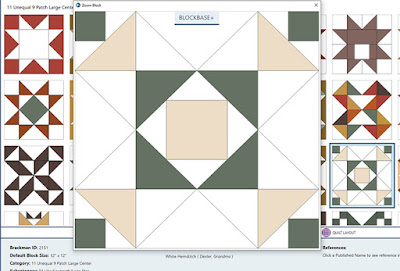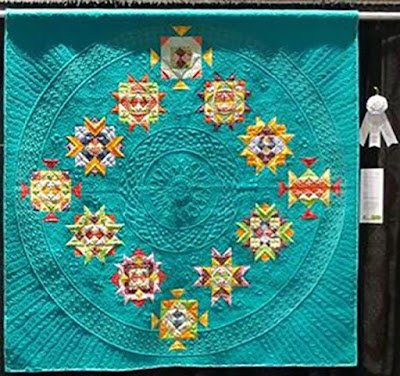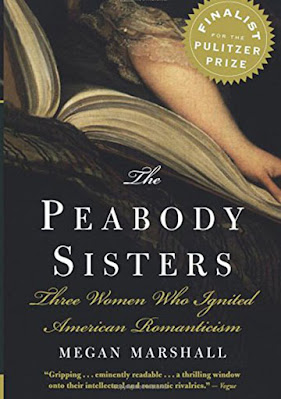Block #9 Hemstitch by Denniele Bohannon
Mid-century seamstress
"24 January. Sewed all morning....I hemmed handkerchiefs for ( nephew)
Horace (Mann), who is going to Cambridge."
Sophia & Nathaniel Hawthorne during the Civil War in front of their
Concord house The Wayside, which they bought from
the Alcotts and expanded. Nathaniel added the tower study.
The house sat on a 17-acre parcel.
Sophia Amelia Peabody Hawthorne (1809-1871)
Nathaniel Hawthorne (1804- 1864) by Charles Osgood, 1841
The Hawthornes married in 1842 and spent their
honeymoon years in Concord's Old Manse, a situation
arranged by Ralph Waldo Emerson (who liked arranging Concord.)
Hemstitch by Addison
If like the Alcotts you couldn't pay the rent he'd pay it for you. If you needed a place to stay he'd put you up in the guest room as he did Henry Thoreau and Margaret Fuller (not together!)
Emerson's house was across the road on the way into town.
Concord looks bucolic. That is probably not Nathaniel Hawthorne
waving to the neighbors here. He is remembered as very shy,
perhaps a man with severe social anxiety.
"Mr H is as queer as ever and we catch glimpses of a dark mysterious lookingman in a big hat and red slippers darting over the hills....as if heexpected the house of Alcott were about to rush out and clutch him."
Bronson, always looking for an audience, was likely to do so.
Hemstitch by Janet Perkins
Louisa refers to Mr. H as Byronic and he was--- an extremely handsome man who wrote romantic poetry and prose. On Hawthorne's first visit to the Peabody sisters' home his future sister-in-law Elizabeth ran upstairs to tell her younger sister Sophia: "He is handsomer than Lord Byron. You must get up and dress and come down." Sophia, who had her own issues, stayed in her room.
Elizabeth Peabody (1804-1894) at Bronson Alcott's Concord
School of Philosophy at Orchard House,
1880s. by Alfred Winslow Hosmer, Concord Library
She eschewed conventions of female fashion and hair dressing.
Did Sophia and Nathaniel break sister Elizabeth's heart when they married five years later? The marriage was fortuitous for Sophia and Nathaniel who produced three handsome offspring in a union Margaret Fuller described as a "happy duet."
Una, Julian and Rose Hawthorne in the 1860s
Una was often in a "high state of wrath and woe," as Louisa noted.
Louisa gossiped a bit about Sophia, telling her cousin, "Mrs. H. is as sentimental and muffing as of old..." (Muffing, Alcott biographer Harriet Reisen tells us, means clumsy.) In turn Sophia disparaged Abba Alcott's tendency to overdramatize the war news.
"Mrs Alcott is the most appalling sensationist. She frightens me out of my five senses from time to time with telling me one thing and another---and suggesting blood-curdling possibilities."
Sophia about the time of the Civil War
Despite occasional spitefulness the Alcotts and the Hawthornes spent much time together according to Sophia's 1862 diary, sharing corn and apple harvests, a cloak pattern loaned by Louisa and many evening games of whist. Una, born in 1844, was friends with May, four years older. Julian, six years younger than May, is thought to have had a crush on that most glamourous Alcott.
"Louisa and Abby [May] go with Una and Julian to see the review of the colored regiments in Readville." Abba Alcott journal, May, 1863.
Sophia's diary drifts off in 1863. The neighbors were helpful in getting Louisa off to her nursing experience in Washington and in her return as an invalid. They sent Louisa's poem mourning Henry D. Thoreau to a newspaper for publication. Nathaniel himself remained aloof. As Sophia wrote: "Mr Hawthorne's abomination of visiting still holds strong... His vocation is to observe and not be observed."
Franklin Pierce (1804-1869)
14th President 1853-1857
Louisa's nursing matron Hannah Ropes called him
"The most unmitigated calamity Heaven ever suffered upon the earth."
The Hawthornes' attitudes about abolition were at odds with her sisters' views and with their literary Concord neighbors. Nathaniel's life-long friend from Bowdoin College years was recent President Franklin Pierce, considered a "doughface," a Northerner with Southern principles. Campaign biographer Hawthorne echoed Pierce's sentiments. Pierce's visits to Concord during the war could not have been welcomed by the neighbors. Franklin Sanborn characterized him as "a copperhead of the worst kind," a synonym for doughface.
Hawthorne's decision to dedicate his 1863 book Our Old Home to Pierce was controversial. “My friends have dropped off from me like autumn leaves,” he acknowledged. Waldo Emerson ripped the laudatory Pierce dedication pages out of his copy.
In the fall of 1862 Sophia recorded spending time at an early wartime endeavor, raveling linen fabric to create "lint," linen threads to send to hospitals to pack wounds.
Exhibit showing "Lint Scraping," which probably would communicate
better to us if it were called "Linen Raveling"
Framingham History Center, Edgell Memorial Library
Waldo's daughter Ellen Emerson wrote her cousin: "We have an institution here called 'lint parties'...Just now all we are sure of is soldiers' sewing one day a week and Lint party Wednesday evenings." Earlier in the year Ellen wrote of a "Mass-meeting of sewers here on Thursday to make clothes for the negroes at Port Royal," people freed by Union occupation of South Carolina's sea islands. Sophia and the children attended several such wartime aid society meetings in the diary year of 1862.
Block #9 Hemstitch by Becky Brown
The Block
Looking for interesting sawtooth stars in the Encyclopedia of Pieced Quilt Patterns and BlockBase+
we find White Hemstitch from a 1930s pattern source named "Grandma Dexter."
BlockBase #2151
Cutting
You need4 A squares
4 B squares
12 C triangles
4 B squares
12 C triangles
4 D triangles
4 E squares
8 F triangles
---------------
Sophia's letters and diaries detail problems with her well-loved husband's health in 1862, '63 and '64. Stomach pain and lethargy were two major symptoms but he was also unsteady on his feet and uncoordinated, a "devastating array of symptoms," according to biographer Brenda Wineapple. Nathaniel had watched two favorite uncles die of some kind of familial neurological disorder with similar symptoms. He kept it to himself.
Una suffered through a broken engagement in 1867 and the following year the family moved to Europe where Sophia edited Nathaniel's writings for publication. She sold the Concord house in 1870 and died of typhoid at the age of 61 in England.
8” Block (2” Grid)
A—Cut squares 2-1/2”
B—Cut squares 5-1/4”. Cut each into 4 triangles with two diagonal cuts.

C—Cut squares 2-7/8”. Cut each into 2 triangles with one diagonal cut.

A—Cut squares 2-1/2”
B—Cut squares 5-1/4”. Cut each into 4 triangles with two diagonal cuts.

C—Cut squares 2-7/8”. Cut each into 2 triangles with one diagonal cut.

D - Cut 1 square 3-1/4". Cut into 4 triangles with two diagonal cuts.
E Cut 4 squares 1-1/2".
F Cut 4 squares 1-7/8". Cut each into 2 triangles with one diagonal cut.
-------------------
12” Block (3” Grid)
A—3-1/2”
B—7-1/4”
C—3-7/8”
12” Block (3” Grid)
A—3-1/2”
B—7-1/4”
C—3-7/8”
D - 4-1/4"
E - 2"
F - 2-3/8"
16” Block (4” Grid)
16” Block (4” Grid)
A—4-1/2”
B—9-1/4”
C—4-7/8”
B—9-1/4”
C—4-7/8”
D - 5-1/4"
E - 2-1/2"
F - 2-7/8"
How-To
Post Script
Nathaniel Hawthorne about 1860
In May, 1864 Hawthorne and Pierce proposed a vacation to Boston, Andover and Plymouth, New Hampshire, Hawthorne in such bad health he had to be carried to the carriage. Even the impractical Bronson Alcott thought the trip a bad idea, but Sophia placed hopes in restorative travel. Did Nathaniel have a plan?
Pemigewasset House, a New Hampshire resort
Wineapple gives us a glimpse of the morning Pierce found Hawthorne dead in his room in a Plymouth hotel. Sophia's sisters Elizabeth and Mary were deputized to break the news to his wife. Several intimates including Elizabeth suspected suicide by self-administered poison but Hawthorne was a sick man and might very well have died peacefully in his sleep far from home.
The family stayed on at Wayside. Julian who'd been failing at Harvard dropped out and came home. Rose almost thirteen and Una about 20 were consolation to their mother although Una seems to have been emotionally overwrought with lifelong tantrums requiring restraint.
Sophia on the west side of Wayside in the 1860s,
wearing the dress seen in the portrait above with her husband.
Several family pictures come from Harvard's Alcott files.
Una suffered through a broken engagement in 1867 and the following year the family moved to Europe where Sophia edited Nathaniel's writings for publication. She sold the Concord house in 1870 and died of typhoid at the age of 61 in England.
Sophia's marker in Concord's Sleepy Hollow cemetery.
In a reprise of the rivalry between their mother and Aunt Elizabeth, Una and Rose fell in love with the same man George Lathrop.
Rose Hawthorne Lathrop (1851-1926)
After George's death Rose became a Catholic nun.
Rose won him; they married in 1871 and bought back the house in Concord where their only son Francis died in 1881. The distraught couple left Wayside and moved to Boston.
Julian and Una Hawthorne
The Hawthornes had more than their share of mental illness's grief. Una died suddenly at the age of 33 after a life marked with intermittent periods of psychosis. Julian lived a long life as a writer but his reputation was rather unsavory and he served time in jail for his financial dealings in a mine.
The Alcott/Hawthorne House over the years.
The Alcotts called it Hillside and sold it to the Hawthornes who called it Wayside.
When considering Little Women it's important to keep in mind that most of the remembered March family events took place at Wayside in the house at top left here ---not next door at Orchard House, a later Alcott purchase. If I were the historian on a Little Women film I'd dictate filming in a Wayside reproduction (historical consultants don't get to dictate however.)
Wayside Set
8" = 40" square quilt.
Cut center 16-1/2" square. Cut borders 4-1/2" x 32-1/2" for sides and 4-1/2" x 40-1/2" for top & bottom.
Cut center 24-1/2" square. Cut borders 6-1/2" x 48-1/2" for sides and 6-1/2" x 72-1/2" for top & bottom.
16" = 80" square quilt
Cut center 32-1/2" square. Cut borders 8-1/2" x 64-1/2" for sides and 8-1/2" x 80-1/2" for top & bottom.
My inspiration was Klonda Holt's and Dorry Hurska's prize-winning collaboration at the Kansas City Regional Quilt Festival last June.
The Peabody Sisters: Three Women Who Ignited American Romanticism by Megan Marshall. Marshall's story ends with Sophia's 1842 wedding. Preview:
An older book: The Peabody Sisters of Salem by Louise Tharpe Hall, 1988
"With Hawthorne in Wartime Concord: Sophia Hawthorne's 1862 Diary" by Thomas Woodson, James A. Rubino and Jamie Barlowe Kayes, Studies in the American Renaissance, 1988.
Extra Reading
Mary Peabody Mann (1806-1887)
The three Peabody sisters Elizabeth, Mary and
Sophia were extraordinary women.
Mary's boys about 1855: Benjamin, Horace Jr. & George.
Mary's husband educator Horace Mann left her a widow in 1859.
Horace went to Harvard; his aunt Sophia sent hand-stitched
handkerchiefs with him. He died of tuberculosis at 24 soon after graduation.
An older book: The Peabody Sisters of Salem by Louise Tharpe Hall, 1988
Hawthorne: A Life by Brenda Wineapple. Preview:
"With Hawthorne in Wartime Concord: Sophia Hawthorne's 1862 Diary" by Thomas Woodson, James A. Rubino and Jamie Barlowe Kayes, Studies in the American Renaissance, 1988.







































4 comments:
Mary Lothrop (author is “Five Little Peppers” series) bought Wayside from the Hawthornes. Today if one visits they see the house as it was when she left it … and it feels remarkably as though the Hawthornes are still there. Sophia refused to see her husband’s body and had friends (including Bronson) go in to affirm it was indeed Nathaniel. Sophia and Una’s remains were brought back to Concord in 2006 in a beautiful ceremony in which the same hearse used for Nathaniel’s internment was used. Concord is one of the most fascinating places in American history and literature!
Matty, I agree---Concord is fabulous. I didn't even get into Mary Lothrop's Five Little Peppers, which I enjoyed as a kid.
We visited Concord back in 1993, when I was just really getting started in quilting. We also visited Amish Country in Lancaster, PA as well as Gettysburg.
I so enjoy your blogs, Barbara, and have some questions I’d like to ask you about Civil War Lexington, Missouri. Do you have an email I can use? Thanks so much! Mine is kbtracy@hitmail.com
Hi Barbara. I really enjoyed your post, what great photographs! I am interested in finding images of the Hawthorne’s at Wayside during 1861-1863 as well as any images from that period of the Alcott’s. My great grandmother was a servant for the Hawthorne’s at the Wayside during that period working as a seamstress (along with other duties). You have wonderful images here, could you recommend where I might find similar images from that period? Thanks so much! Cheers—Bridget
Post a Comment